英美小说要素解析
《了不起的盖茨比》文学五要素分析

《了不起的盖茨比》文学五要素分析《了不起的盖茨比》是美国作家F·斯科特·菲茨杰拉德于1925年创作的长篇小说,被誉为20世纪最伟大的小说之一、这部小说以20世纪20年代美国为背景,通过描绘主人公盖茨比不屈不挠的追求和对梦想的执着追求,深刻剖析了美国社会的虚伪与空洞。
其文学价值在于对爱情、财富、虚荣等主题的深入挖掘,并通过一系列独特的文学要素来展现这些主题。
首先,小说涵盖了丰富的情节,从而增强了作品的吸引力和可读性。
故事以主人公尼克·卡拉威为叙述者,讲述了他在长岛上的邻居盖茨比的故事,引发了读者对盖茨比的好奇心。
小说中,盖茨比通过财富和奢华的生活方式来吸引梦中情人黛西,展示了他对黛西的深情和执着。
同时,小说还展现了20年代美国社会的暴露和矛盾,通过对冷漠和虚伪的描绘,揭示了社会道德和人际关系的脆弱性。
其次,小说中的人物塑造也是其文学要素之一、主人公盖茨比是一个富有的商人,他通过经商致富,但内心却一直向往着不可触摸的东西,即他的梦中情人黛西。
虽然他冒险改变了自己的身份,但在追求中却逐渐失去了自我的真实性,成为一个被虚荣驱使的人。
而黛西则是一个典型的小资产阶级女性,追求物质享受和社会地位,对待感情和责任缺乏诚意。
通过对这些角色的细腻描写和刻画,小说展现了社会背景对个人命运的影响。
此外,小说也通过描写细腻的环境来增强故事的真实感。
作品中的长岛代表着20年代美国经济繁荣和社交场所的繁忙,尤其是盖茨比的豪华别墅成为他奢靡生活的象征。
而小说中对于瓦莱特谷的描写则代表着腐败和浪费。
通过这些环境描绘,小说帮助读者更好地理解和感受到了社会和角色的特殊性。
总之,《了不起的盖茨比》通过丰富多样的情节、鲜明独特的人物塑造、细腻描绘的环境、巧妙运用的文学手法等文学要素的运用,揭示了20年代美国社会的矛盾和人性的脆弱。
这部小说不仅具有很高的艺术价值,而且深入挖掘了人类社会的本质和困境,对于读者来说具有深远的思考和启示意义。
掌握英美短篇小说的技巧:总结分享

掌握英美短篇小说的技巧:总结分享。
一、先读概要英美短篇小说通常篇幅较短,有时只有几页甚至只有几十行。
但是,短篇小说的情节通常安排紧凑,语言也较为简练,所以很容易让人产生阅读疲劳。
因此,在阅读英美短小说之前,建议先读一遍概要,了解故事大意和悬念,这样有助于把握故事情节的转折点和结局,也可以帮助读者更加专注于文本。
二、注重语言细节英美短篇小说的语言精炼,注重细节。
在阅读过程中,注意观察作者用词的特点和技巧,了解作者的文化背景和思想倾向,同时也可以从中学习一些语言细节和表达技巧。
比如,通过对比作者使用的动词、形容词和副词,可以了解文本的情感色彩和文化价值观。
此外,英美短篇小说通常会运用一些比喻和象征手法,这些手法不仅可以增强作品的艺术感染力,也可以帮助读者更好地理解文本的内涵。
三、重视故事结构故事结构是英美短篇小说的核心之一。
它主要包括情节、人物和主题三个要素。
在阅读英美短篇小说时,需要仔细研究这三个要素之间的关系和发展,注意故事的节点和高潮,并思考作者想要表达的主题和意义。
此外,在了解故事结构的基础上,还可以尝试借鉴其中的一些写作技巧,比如跳跃式叙事、多视角叙事、闪回和字里行间等。
四、不断拓展阅读材料英美短篇小说种类繁多,涉及到很多不同的文学流派和文化背景。
为了更好地掌握英美短篇小说,需要不断拓展阅读材料,涉猎不同的题材和风格,了解不同作者的写作特点和文化背景。
这不仅可以拓展学习者的思维和视野,也可以帮助读者更好地掌握英语语言和文化。
掌握英美短篇小说需要一定的阅读技巧和方法。
通过先读概要、注重语言细节、重视故事结构和不断拓展阅读材料,可以帮助读者更好地理解文本和把握故事情节,提高阅读水平和语言能力。
英美文学作品文体特点解读——以小说为例

082谈及英美文学作品文体特点的解读多是从作品的题目、结构和衔接方法等多方面入手,以便于更好地与作者进行语言互动,了解作者的创作感情和动机,为自己进行文学创作奠定基础,同时还能帮助读者理解作品的核心内涵。
小说作为英美文学作品不可或缺的重要构成,拥有广泛的读者群体。
通过对经典的英美文学小说作品的对比分析可以发现,经典英美小说的内容和精神内涵都相当丰富,读者能从这些作品中获得高度的精神享受。
因此,本文以英美文学小说为重点研究对象,从英美小说中的连贯性词汇、文章结构等多方面出发,剖析英美小说的写作特征和相关写作技巧的应用,以期引导英美小说的受众群体领会作品的深刻内涵。
一、英美文学作品解读的基本原理英美文学作品的解读多是基于语篇分析。
语篇通常是指在不受语言结构限制的前提下,能通过连续的句子和文段表达出完整的意思,语篇中的每个语句都带有语篇的基本特征,具体表现为结构性和非结构性[1]。
语篇分析是利用相对较长的语段体现语言的基本特征和交际属性,将其作为系统化分析的主要对象。
语篇分析包括内容、结构以及联合分析等方面,由此也可以看出,语篇分析是以语篇为文体解读的基础,开展深入剖析和评估,从语篇的整体内容切入,不再局限于语篇的描写和思想层面,而是从语篇的遣词造句、段落间的衔接、连贯、创作手法等层面进行研究。
二、文体解读的主要内容(一)结构层面的解读一篇文学作品往往是作者通过相应的逻辑思维将词语和句子进行组合,由此组合而成的内容往往决定了作品的结构。
虽然文学作品的内容形式变换方式是相当丰富多样的,但作品的结构还是存在很大的局限性,思维逻辑也比较有限。
英美文学作品的结构包括四类:说明、叙事、描写和议论。
不同结构运用的技巧和方法也不同,基于不同的思维对作品的结构分析也存在差异。
例如侧重于刻画结构的作品,常利用文字描写人、物、景等,通过将作者的感官细节进行具象化的描绘和展开,能较好地传递作者的五官感受,并将作品中的人物形象刻画得更加细致。
英美成长小说及其叙事特征
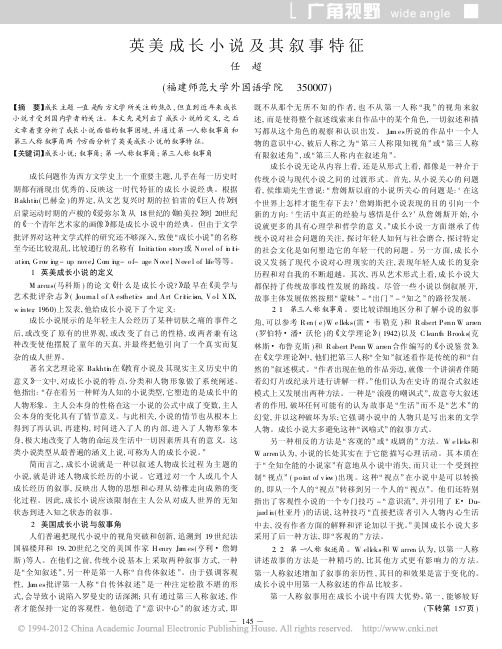
英美成长小说及其叙事特征任超(福建师范大学外国语学院350007)=摘要>成长主题一直是西方文学所关注的焦点,但直到近年来成长小说才受到国内学者的关注。
本文先是列出了成长小说的定义,之后文章着重分析了成长小说面临的叙事困境,并通过第一人称叙事角和第三人称叙事角两个方面分析了英美成长小说的叙事特征。
=关键词>成长小说;叙事角;第一人称叙事角;第三人称叙事角成长问题作为西方文学史上一个重要主题,几乎在每一历史时期都有涌现出优秀的、反映这一时代特征的成长小说经典。
根据Bakhti n(巴赫金)的界定,从文艺复兴时期的拉伯雷的5巨人传6到启蒙运动时期的卢梭的5爱弥尔6,从18世纪的5帕美拉6到20世纪的5一个青年艺术家的画像6都是成长小说中的经典。
但由于文学批评界对这种文学式样的研究还不够深入,致使/成长小说0的名称至今还比较混乱,比较通行的名称有Initi a ti on story或N ovel o f i n i t-i ation,G ro w i ng-up nove,l Co m i ng-o f-age N ove,l N ove l of life等等。
1英美成长小说的定义M arcus(马科斯)的论文5什么是成长小说?6最早在5美学与艺术批评杂志6(Journa l o f A estheti cs and A rt Cr i tic i s m,V o.l X IX, w inter,1960)上发表,他给成长小说下了个定义:成长小说展示的是年轻主人公经历了某种切肤之痛的事件之后,或改变了原有的世界观,或改变了自己的性格,或两者兼有这种改变使他摆脱了童年的天真,并最终把他引向了一个真实而复杂的成人世界。
著名文艺理论家Bakhti n在5教育小说及其现实主义历史中的意义6一文中,对成长小说的特点、分类和人物形象做了系统阐述。
他指出:/存在着另一种鲜为人知的小说类型,它塑造的是成长中的人物形象。
英美小说要素解析1

1. Be here! Attendance will be recorded and it is part of your final score.
2. Don’t be late. If you are, say you’re sorry. 3. Don’t have any kind of food here. 4. No cell phone can be used in the
Dickens wrote flat characters superbly well. Nearly every one can be summed up in a sentence, and yet there is this wonderful feeling of human depth. Probably the immense vitality of Dickens causes his characters to vibrate a little, so that they borrow his life and appear to lead one of their own.
/wiki/Novel
A novel is a book of long narrative in literary prose.
Prose: the most typical form of language, applying ordinary grammatical structure and natural flow of speech rather than rhythmic structure (as in traditional poetry).
A specific novel can have these "eternal qualities" of art, this "deeper meaning" an interpretation tries to reveal.
多模态视角下英美文学名篇解读
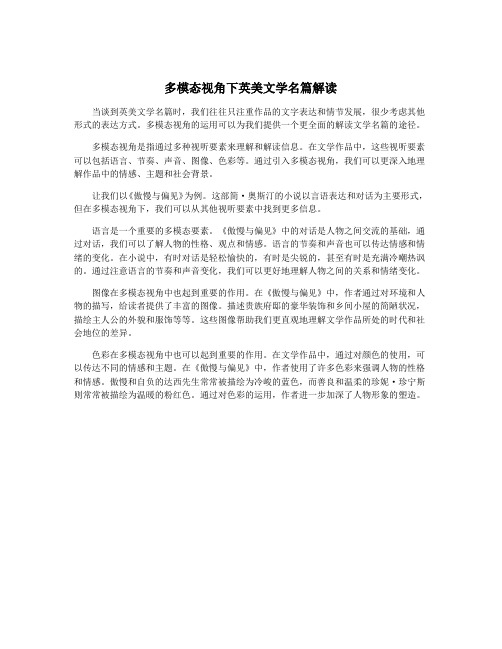
多模态视角下英美文学名篇解读当谈到英美文学名篇时,我们往往只注重作品的文字表达和情节发展,很少考虑其他形式的表达方式。
多模态视角的运用可以为我们提供一个更全面的解读文学名篇的途径。
多模态视角是指通过多种视听要素来理解和解读信息。
在文学作品中,这些视听要素可以包括语言、节奏、声音、图像、色彩等。
通过引入多模态视角,我们可以更深入地理解作品中的情感、主题和社会背景。
让我们以《傲慢与偏见》为例。
这部简·奥斯汀的小说以言语表达和对话为主要形式,但在多模态视角下,我们可以从其他视听要素中找到更多信息。
语言是一个重要的多模态要素。
《傲慢与偏见》中的对话是人物之间交流的基础,通过对话,我们可以了解人物的性格、观点和情感。
语言的节奏和声音也可以传达情感和情绪的变化。
在小说中,有时对话是轻松愉快的,有时是尖锐的,甚至有时是充满冷嘲热讽的。
通过注意语言的节奏和声音变化,我们可以更好地理解人物之间的关系和情绪变化。
图像在多模态视角中也起到重要的作用。
在《傲慢与偏见》中,作者通过对环境和人物的描写,给读者提供了丰富的图像。
描述贵族府邸的豪华装饰和乡间小屋的简陋状况,描绘主人公的外貌和服饰等等。
这些图像帮助我们更直观地理解文学作品所处的时代和社会地位的差异。
色彩在多模态视角中也可以起到重要的作用。
在文学作品中,通过对颜色的使用,可以传达不同的情感和主题。
在《傲慢与偏见》中,作者使用了许多色彩来强调人物的性格和情感。
傲慢和自负的达西先生常常被描绘为冷峻的蓝色,而善良和温柔的珍妮·珍宁斯则常常被描绘为温暖的粉红色。
通过对色彩的运用,作者进一步加深了人物形象的塑造。
英美小说课件
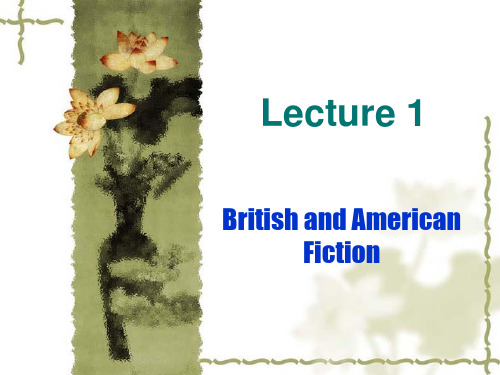
The reading process is interactive, as meaning can only be discovered and constructed by the reader. Fiction has no real existence until it is read and understood. Almost any story has different meanings to different people, depending on their age, education, gender, nationality, political and religious beliefs, social and economic classes, and personal life experiences. It is a mistake to think that, for each story, there is only “correct” interpretation for all readers.
Questions: 1.According to the Bible, how was human created? 2. How is the first woman created? 3. From this description, what is the relationship between Adam and Eve /man and woman? 4. Have you noticed any problem concerning the relationship between man and woman? 5. What is your opinion on the relationship between man and woman?
英美小说要素解析

英美小说要素解析Plot: A Sequence of Interrelated Actions or Events. Plot, or the structure of action, it generally refers to the scheme or pattern of events in a work of fiction. A plot is a plan or groundwork for a story, based on conflicting human motivations, with the actions resulting from believable and realistic human response.Types of Conflict:①External Conflict: Man and nature, man and society, and man and man.②Internal Conflict: It focuses on two or more elements contesting within the protagonist’s own character.Exposition(情节交代): It is where everything is introduced is the beginning section in which the author provides the necessary background information, sets and scene, establishes the situation, and dates the action. It usually introduces the characters and the conflict, or at least the potential for conflict.Complication(纠葛): Which is sometimes referred to as the rising action, develops and intensifies the conflict. The rising action(起始行动) is when things begin to escalate. It takes the reader from the exposition and leads them towards the climax. This part tends to be dramatic and suspenseful.Climax(高潮):When you finally take a breath after holding it in suspense. This is the most emotional part of the book.Crisis(关子):It( also referred to as the climax) is that moment at which the plot reaches its point of greatest emotional intensity; it is the turning point of the plot, directly precipitating the resolution. It is the reversal or” turning point”.Falling action(下降行动):Once the crisis, or turning point, has been reached, the tension subsides and the plot movestoward its conclusion. It is when everything tends to slow down, and the climax is over.Resolution(冲突解开):It is the final section of the plot which records the outcome of the conflict and establishes some new equilibrium. The resolution is also referred to as the conclusion, the end or the denouement. This is the final part of the story when everything is wrapped up. Sometimes the story is finished off completely, answering every reader's question. Sometimes authors leave mysterious, to intrigue the reader. Or sometimes authors leave hints of a sequel.Catastrophe: Applied to tragedy only.Denouement:Applied to both comedy and tragedy.The ordering of plot—Chronological plotting—Flashback: It is interpolated narratives or scenes( often justified, or naturalized, as a memory, a reverie, or a confession by one of the characters) which represent events that happened before the time at which the work opened.Character:They are the persons represented in a dramatic or narrative work, who are interpreted by the reader as being endowed with particular moral, intellectual, and emotional qualities by inferences from what the persons say and their distinctive ways of saying it –the dialogue—and from what they do—the ac tion. A character may remain essentially“stable,”or unchanged in outlook and disposition, from beginning to end of a work, or may undergo a radical change, either through a gradual process of development, or as the result of a crisis. Whether a character remains stable or changes, the reader of a traditional and realistic work expects “consistency”--- ---the character should not suddenly break off and act in a way not plausibly grounded in hisor her temperament as we have already come to know it.Motivation: The grounds in the characters temperament, desires, and moral nature for their speech and actions.Types of characters—protagonist: The chief character in a plot, on whom our interest centers.(or alternatively, the hero or heroine) It is the major, or central, character of the plot.Antagonist: If the plot is such that he or she is pitted against and important opponent, that character is called the antagonist. It is his opponent, the character against whom the protagonist struggles or contends.Flat characters: they are those who embody or represent a single characteristic, trait, or idea, or at most a very limited number of such qualities. Flat characters are also referred to as type characters, as one-dimensional characters, or when they are distorted to create humor, as caricatures.Stock characters: Flat characters have much in common with the kind of stock characters who appear again and again in certain types of literary works. A flat character (also called a type, or “two-dimensional”), Forster says, is built around “a single idea or quality”and is presented without much individualizing detail, and therefore can be fairly adequately described in a single phrase or sentence.Round characters: They are just the opposite. They embody a number of qualities and traits, and are complex multidimensional characters of considerable intellectual and emotional depth who have the capacity to grow and change. A round character is complex in temperament and motivation and is represented with subtle particularity; such a character therefore is as difficult to describe with any adequacy as a person in real life, and like real persons, is capable of surprising us.Dynamic characters: They exhibit a capacity to change; static characters do not. As might be expected, the degree and rate of character change varies widely even among dynamic characters.Static characters: They leave the plot as they entered it, largely untouched by the events that have taken place.Methods of characterization-- Telling: It relies on exposition and direct commentary by the author.In telling, the author intervenes authoritatively in order to describe, and often to evaluate, the motives and dispositional qualities of the characters. Characterization through the use of names, through appearance, and by the author. Showing: It involves the author’s stepping aside, as it were, to allow the characters to reveal themselves directly through their dialogue and their actions. In showing(also called“the dramatic method”), the author simply presents the characters talking and acting and leaves the reader to infer the motives and dispositions that lie behind what they say and do.The author may show not only external speech and actions, but also a character’s inner thoughts, feelings, and responsiveness to events; for a highly developed mode of such inner showing, see stream of consciousness. Characterization through dialogue, and action.Setting: The stage against which the story unfolds.( Place and objects in fiction) The overall setting of a narrative or dramatic work is the general locale, historical time, and social circumstances in which its action occurs; the setting of a single episode orscene within such a work is the particular physical location in which it takes place. Types of setting—Natural and Manufactured The language used in description of settingThe functions of setting: Setting as a background for action,antagonist, a means of creating appropriate atmosphere, a means of revealing character, and a means of reinforcing theme.Point of view: The events of a story may be told as they appear to one or more participants or observers. In first-person narration the point of view is automatically that of the narrator.More variation is possible in third-person narration, where the author may choose to limit his or her report to what could have been observed or known by one of the characters at any given point in the action--- or may choose to report the observations and thoughts of several characters. The author might choose to intrude his or her own point of view.Narrator: It is the speaker or the voice of the literary text, the agent who does the narration. The narrator, like any character in fiction, only exists in a narrative, and he cannot be identified with anything of the real-life author of a literary work.Various points of view—First person:①Advantages: First, he creates an immediate sense of reality. Second, the writer has a ready-made principle of selection.② Difficulties: It may only strike us when we try to write stories ourselves.Second personThird person: There are three variants: omniscient, limited omniscient, and objective or dramatic.Mingling of points of view: It is because for the purpose of sustaining interest or creating suspense.A brief summary: 1. First person( I): All these first-person narrators may have(1) complete understanding,(2) partial or incorrect understanding, or(3) no understanding at all.①Major participantⅰtelling his or her story as a major mover,ⅱtelling a story about others and also about herself or himself as one ofthe major inter-actors,ⅲtelling a story mainly about others; this narrator is on the spot and completely involved but is not a major mover.②Minor participant, telling a story about events experienced and/ or witnessed.③Uninvolved character, tellin g a story not witnessed but reported to the narrator by other means.2. Second person( you): Occurs only when speaker has more authority on a character’s action than the character himself or herself. Occurs only in brief passages when necessary.3. Third p erson( she, he, it, they):①Omniscient. Omniscient speaker sees all, reports all, knows inner workings of minds of characters.②Limited omniscient. Action is focused on one major character.③Dramatic or third-person objective. Speaker reports only actions and speeches. Thoughts of characters can be expressed only as dialogue.Theme: It is the central idea or a statement about life that unifies and controls the total work.Points of theme:1. A theme does not exist as an intellectual abstraction that an author superimposes on the work like icing on a cake.2. The theme may be less prominent and less fully developed in some works of fiction than in others.3. It is entirely possible that intelligent readers will differ, at times radically, on just what the themeof a given a work is.4. The theme of a given work need not be in accord with the reader’s particular beliefs and values. As a general rule, then, we should assume that the ideas of authors grow out of their values, and that values are embodied in their stories along with the ideas. But we must remember that although literature is full of ideas that may strike us, at least initially, as unpleasant, controversial, or simply wrongheaded, literary sophistication and plain common sense should warn usagainst dismissing them out of hand.Identifying theme:1. It is important to avoid confusing a work’s theme with its subject or situation.2. We must be as certain as we can that our statement of theme does the work full.3. The test of any theme we may propose is whether it is fully and completely supported by the work’s other elements.4. The title an author gives the work often suggests a particular focus or emphasis for the reader’s attention.Style: It has traditionally been defined as the manner of linguistic expression in Prose or verse--as how speakers or writers say whatever it is that they say. TheWord style, derived from the Latin word stilus, is understood to mean the way in which writers assemble words to tell the story, develop the argument, dramatize the play, or compose the poem. Style is to be judged on the degree of its adaptability. Elements of style—Diction: Choice of words, and Syntax: Construction of sentences.Oedipus complex: ①It is a term coined by Sigmund Freud to designate a son’s subconscious feel ing of love toward his mother and jealousy and hatred toward his father. ②D.H. Lawrence’s Sons and Lovers is a case in point.Tone: It refers to the methods by which writers convey attitudes, it refers not to attitudes but to those techniques and modes of presentation that reveal or create these attitudes. It is a means of creating a relationship or conveying an attitude.Types of irony:1. Verbal irony: It is a statement in which one thing is said and another is meant.2. Situational irony: It or irony of situation, refers to conditions that are measured against forces that transcend and overpower human capacities.3. Dramatic irony: It is a special kind of situational irony; it applies when acharacter perceives a situation in a limited way while the audience, including other characters, may see it in greater perspective.1.1 The Bride Comes to Yellow Sky—Stephen Crane 1.2 Christmas Day in the Morning—Pearl S. Buck2.1 The Catbird Seat—James Thurber 2.2 Two kinds—Amy Tan3.1 To Build a Fire—Jack London 3.2 A Horseman in the Sky—Ambrose Bierce4.1 A Clean, Well-lighted Place—Ernest Hemingway 4.2 The Broken Globe—Henry Kreisel5.1 Yellow Woman—Leslie Silko 5.2 Rain—W. Somerset Maugham6.1 My Oedipus Complex—Frank O’Connor 6.2 Haircut—Ring Lardner7.1 The Horse D ealer’s Daughter—D.H. Lawrence 7.2 Luck—Mark Twain。
成为英美短篇小说达人的秘诀:教学总结
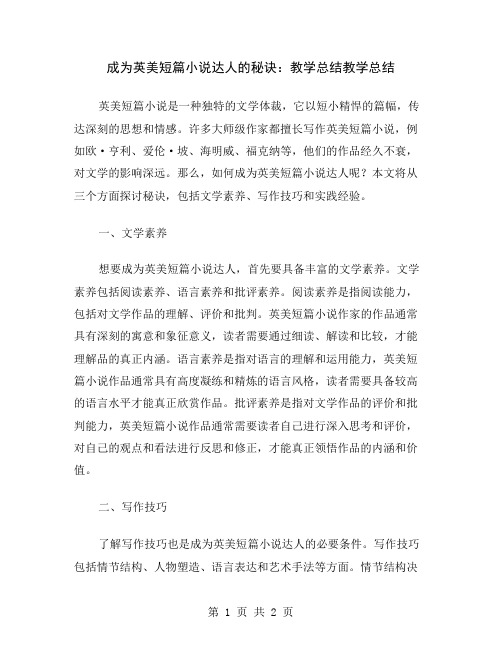
成为英美短篇小说达人的秘诀:教学总结教学总结英美短篇小说是一种独特的文学体裁,它以短小精悍的篇幅,传达深刻的思想和情感。
许多大师级作家都擅长写作英美短篇小说,例如欧·亨利、爱伦·坡、海明威、福克纳等,他们的作品经久不衰,对文学的影响深远。
那么,如何成为英美短篇小说达人呢?本文将从三个方面探讨秘诀,包括文学素养、写作技巧和实践经验。
一、文学素养想要成为英美短篇小说达人,首先要具备丰富的文学素养。
文学素养包括阅读素养、语言素养和批评素养。
阅读素养是指阅读能力,包括对文学作品的理解、评价和批判。
英美短篇小说作家的作品通常具有深刻的寓意和象征意义,读者需要通过细读、解读和比较,才能理解品的真正内涵。
语言素养是指对语言的理解和运用能力,英美短篇小说作品通常具有高度凝练和精炼的语言风格,读者需要具备较高的语言水平才能真正欣赏作品。
批评素养是指对文学作品的评价和批判能力,英美短篇小说作品通常需要读者自己进行深入思考和评价,对自己的观点和看法进行反思和修正,才能真正领悟作品的内涵和价值。
二、写作技巧了解写作技巧也是成为英美短篇小说达人的必要条件。
写作技巧包括情节结构、人物塑造、语言表达和艺术手法等方面。
情节结构决定了小说的基本组织形式,包括开头、情节发展、高潮和结尾等部分。
人物塑造是指描述小说中的人物形象和性格特点,通过人物的言行和行动揭示作品的主题和思想。
语言表达是指通过精炼的语言塑造意境和情感,吸引读者的眼球。
艺术手法是指在小说创作中运用的各种技巧和手法,如对比、反转、暗示、象征等,增强作品的艺术效果。
三、实践经验成为英美短篇小说达人,还需要掌握一定的实践经验。
实践经验包括写作经验和编辑经验。
写作经是指对写作过程的理解和经验积累,写作是一个积累的过程,只有不断尝试和反思,才能不断提高自己的写作水平。
编辑经验是指对写作作品的编辑和修改经验,英美短篇小说通常具有高度凝练和精炼的特点,需要通过不断的修改和打磨,才能达到完整的艺术效果。
《了不起的盖茨比》文学五要素分析

《了不起的盖茨比》文学五要素分析一、背景:小说设置的大背景是在美国的二十世纪二十年代,当时被叫做“咆哮的二十年代”。
由于美国经济的飞速发展使美国一跃成为世界经济的领跑者。
在那个时代,资本家经济得到了空前的发展。
百万富翁是当时典型的代表人物。
财富的多少成了评判一个人成功与否的标准,人们开始了盲目地赚钱,赚“快”钱,赚更多的钱;追逐变富裕,变得更富裕……同时,美国的享乐主义、斯宾塞的进化论和詹姆斯的实用主义哲学在美国大行其道,传统清教徒式的道德观念和宗教信仰所推崇的“勤劳节俭”等思想,逐渐被追求个人财富、享受物质生活等消费享乐主义所取代。
主人公盖茨比就是当时一个小有成就的资本家。
小说展开的具体背景设定在现代化的美国社会中上阶层的白人圈内,地点是纽约市及长岛。
二、情节线索:小说中充斥着大大小小各种各样的聚会,全书也用了大量篇幅来描写这些聚会的场景,这成了贯穿整个故事的一条线索,每一次的聚会都会推动情节的发展。
《了不起的盖茨比》篇幅不长,全书共分为九章,每章的大致内容如下:第一章“我”初到西卵,与黛西、汤姆及贝克共进晚餐;第二章初见汤姆情妇茉特尔;第三章受邀参加宴会,初识盖茨比;第四章了解到盖茨比与黛西之间的往事;第五章在“我”的帮助下,盖茨比与黛西最终相见;第六章黛西与汤姆参加盖茨比的宴会;第七章汤姆与盖茨比的争吵、茉特尔的意外身亡;第八章盖茨比的回忆及盖茨比之死;第九章无人的葬礼。
按照故事的开始、发展、高潮、尾声,小说可以分为四大部分。
第一部分为一、二两章,这两章描写了两次聚会,看似只是作者漫无目的的回忆,但却为整本小说做了很重要的铺垫——交代了小说中出现的主要环境和人物关系,两次聚会中关于盖茨比简短而又不明了的对话,更为盖茨比究竟是何人物设下悬念。
接下来,“我”神秘的邻居盖茨比终于出现,在第三章到第六章中,情节得到了进一步的发展。
虽然故事的一角已被掀开,我们已知不会有个寻常的结局,但正像主人公对自身的命运无法预知一样,我们仍不能料想小说会迎来怎样的尾声,盖茨比究竟能如愿和黛西走到一起吗?我们充满着好奇。
英美短篇小说文本分析与鉴赏
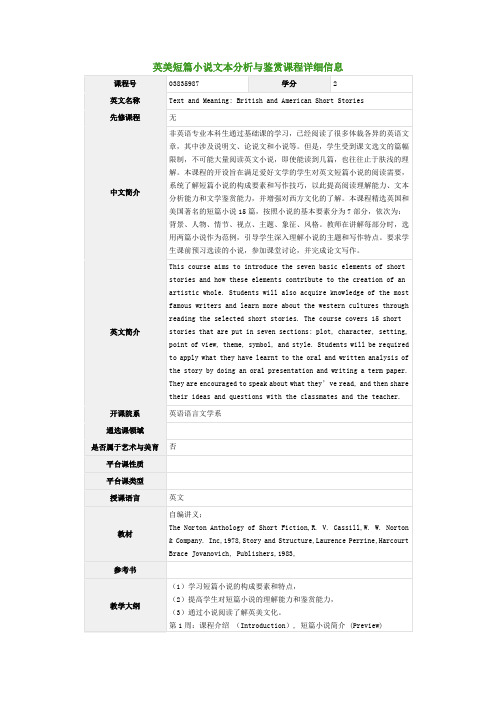
第9周: Katherine Mansfield, Miss Brill
第10周:主题 (Theme) Kurt Vonnegut , Harrison Bergeron
第11周: Frank Stockton, The Lady, or the Tiger?
第16周:复习 (Review)
(1)每个要素的第一篇故事以教师讲授为主,辅以小组讨论和课堂问答
(2)每个要素的第二篇故事由学生作小组展示,教师补充并进行小组讨论
(1)出勤:10%
(2)课堂参与:10% (课堂回答问题和小组讨论参与情况评估)
(3)小组展示:10%
(4)论文:10%
(5)期末考试:60%
开课院系
英语语言文学系
通选课领域
是否属于艺术与美育
否
平台课性质
平台课类型
授课语言
英文
教材
自编讲义;
The Norton Anthology of Short Fiction,R. V. Cassill,W. W. Norton & Company. Inc,1978,Story and Structure,Laurence Perrine,Harcourt Brace Jovanovich, Publishers,1983,
英文简介
This course aims to introduce the seven basic elements of short stories and how these elements contribute to the creation of an artistic whole. Students will also acquire knowledge of the most famous writers and learn more about the western cultures through reading the selected short stories. The course covers 15 short stories that are put in seven sections: plot, character, setting, point of view, theme, symbol, and style. Students will be required to apply what they have learnt to the oral and written analysis of the story by doing an oral presentation and writing a term paper. They are encouraged to speak about what they’ve read, and then share their ideas and questions with the classmates and the teacher.
英文小说从要素分析
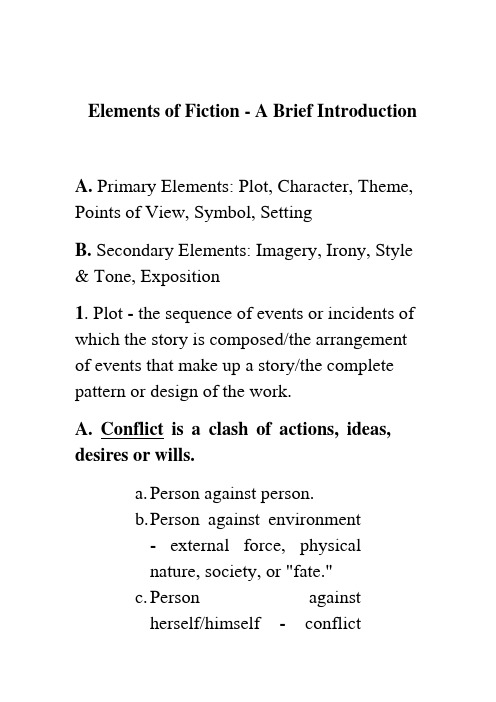
Elements of Fiction - A Brief IntroductionA. Primary Elements: Plot, Character, Theme, Points of View, Symbol, SettingB. Secondary Elements: Imagery, Irony, Style & Tone, Exposition1. Plot - the sequence of events or incidents of which the story is composed/the arrangement of events that make up a story/the complete pattern or design of the work.A. Conflict is a clash of actions, ideas, desires or wills.a.Person against person.b.P erson against environment- external force, physicalnature, society, or "fate."c.Person againstherself/himself - conflictwith some element inher/his own nature; maybephysical, mental, emotional,or moral.d.P erson against God-Greekmythology.B. Artistic Unity - essential to a good plot; nothing irrelevant that does not contribute to the total meaning; nothing that is there only for its own sake or its own excitement.C. Plot Manipulation and Fabulation - a good plot should not have any unjustified or unexpected turns or twists, no false leads, and no deliberate and misleading information; fabulation is the introduction of the fabulous or unrealistic or gothic elements in an otherwise realistic setting.D. Story Ending: In a Happy Ending thestereotypical expectation is that the protagonist must solve all the problems, defeat the villain, win the girl, and live happily everafter. Unfortunately, many real life situations have unhappy endings; for the writers of serious fiction, the unhappy endings are more likely to raise significant issues concerning life and living.E. Types of Plot:a. Tragedy(noble)b. Comedy(less great/noble)c. Romance(less great/noble)d. Satire (used to teach lesson or present a point of viewF. Use of Plot:a. The structure of its actionsb. Order: 1st, 2nd, 3rd…c. To create(The author uses actions as a painter uses paints to create)d. To achieve particular words to create certain effect2. CharacterA. Direct Presentation - author tells us straight out, by exposition or analysis, or through another character.B. Indirect Presentation - author shows us the character in action; the reader infers what a character is like from what she/he thinks, or says, or does. These are also called dramatized characters and they are generally consistent (in behavior), motivated (convincing), and plausible (lifelike).C. Character Types - a Flat character is known by one or two traits; a Round character is complex and many-sided; aStock character is a stereotyped character (a mad scientist, the absent-minded professor, the cruel mother-in-law); a Static character remains the same from the beginning of the plot to the end; and a Dynamic (developing) character undergoes permanent change. This change must be a. within the possibilities of the character; b. sufficiently motivated; and c. allowed sufficient time for change.D. Protagonist and Antagonist - the protagonist is the central character, sympathetic or unsympathetic. The forces working against her/him, whether persons, things, conventions of society, or traits of their own character, are the antagonists.3. Theme - the controlling idea or central insight. It can be 1. a revelation of human character; 2. may be stated briefly or at great length; and 3. a theme is not the "moral" of the story.A. A theme must be expressible in the form of a statement - not "motherhood" but "Motherhood sometimes has more frustration than reward."B. A theme must be stated as a generalization about life; names of characters or specific situations in the plot are not to be used when stating a theme.C. A theme must not be a generalization larger than is justified by the terms of the story.D. A theme is the central and unifying concept of the story. It must adhere to the following requirements:1. It must account for all the major details of the story.2. It must not be contradicted by any detail of the story.3. It must not rely on supposed facts - facts not actually stated or clearly implied by the story.E.There is no one way of stating the theme of a story.F. Any statement that reduces a theme to some familiar saying, aphorism, or clichéshould be avoided. Do not use "A stitch in time saves nine," "You can't judge a book by its cover, " "Fish and guests smell in three days," and so on.。
英美文学名词解释汉语版

英美文学名词解释汉语版
1. 小说 (Novel): 是一种长篇的虚构故事,通常以人物形象和情节为主要构成要素。
2. 散文 (Prose): 是一种以自由的、非诗歌形式的文学作品,通常有较为正式的句子结构和逻辑表达方式。
3. 诗歌 (Poetry): 是一种以押韵、节奏和音乐性为特点的文学形式,通常用比喻、象征和意象来表达作者的情感和观点。
4. 戏剧 (Drama): 是一种能够在舞台上演出的文学形式,通常包括对话、角色互动和舞台指导。
5. 悲剧 (Tragedy): 是一种戏剧类型,通常描绘了主角在命运和自身缺陷之间的斗争,并以悲惨结局告终。
6. 喜剧 (Comedy): 是一种戏剧类型,通常以幽默和滑稽情节为特点,旨在给观众带来愉快和欢笑。
7. 叙事诗 (Epic poem): 是一种长篇叙事诗歌,从古代传统英雄故事中派生而来,通常讲述了一个英雄或重大事件的史诗式叙事。
8. 短篇小说 (Short story): 是一种长度较短的虚构故事,通常聚焦于一个具体的事件或角色,呈现出作者的观点或主题。
9. 传记 (Biography): 是一种通过详细描述一个人的生平和事迹来记录他们的生活和成就的文学作品。
10. 自传 (Autobiography): 是一种以作者自己的经历和回忆为基础写成的传记,通常描绘了作者的成长经历和个人观点。
小说要素(Factors of Fiction)美国文学
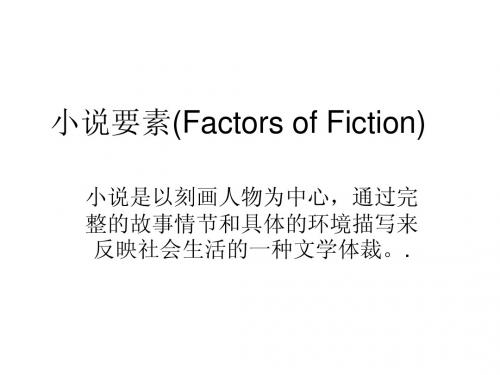
小说是以刻画人物为中心,通过完 整的故事情节和具体的环境描写来 反映社会生活的一种文学体裁。.
• 小说有三个要素:人物、故事情节、环境 (自然环境和社会环境)。
小说各要素的作用
• 人物是小说的核心 • 情节是小说的骨架 • 环境是小说的依托
• 主要手段是塑造人物形象 • 小说中的人物,称为典型人物.可以通过人 物的外貌、动作,语言,心理,神态进行 描写 ; • 环境包括自然环境和社会环境 ; • 故事情节包括 开端,发展,高潮,结局.
Байду номын сангаас 代表作品
• 代表作品:小说《黑猫》、《厄舍府的倒 塌》,诗《乌鸦》
• 爱伦· 坡、安布鲁斯.布尔斯(1842~ 1914?)和H.P.洛夫克拉夫特(1890~ 1937)并称为美国三大恐怖小说家
Edgar Allan Poe 埃德加.爱伦.坡
• • • • • • • 国籍:美国 出生地:波士顿 出生日期:1809年1月19日 逝世日期:1849年10月7日 职业:诗人,小说家,评论家 毕业院校:弗吉尼亚大学 主要成就:侦探小说、恐怖小说、效果论、
• 侦探小说(detective story)鼻祖、科幻小说 (science fiction)先驱之一、恐怖小说(horror fiction)大师、短篇哥特小说巅峰、象征主义 (symbolism)先驱之一,唯美主义 (aestheticism)者。
英美小说要素解析 To build a fire

Group 6
What is the dominant mood of the story? How does London's prose style(particularly his use of imagery) serve to eatablish and then to intensify that mood?
London’s Writting Style
Social Darwinism: the survival of the fittest
Naturalism mingled with Romanticism Forceful and colorful
Subjectivity and enthusiasm His characterizations were often stiff and
4. The whole story shows the depression and melancholy.
How does London's prose style(particularly his use of
imagery) serve to eatablish and then to intensify that mood?
Second style----The author operates as a third
person and an outside odserver; he tells the story in an objective way as he knows everything and it is on concern for the man.
We can draw a conclusion that : the theme of this story is: The fittest survive.
专业的英美文学分析

专业的英美文学分析英美文学是指英国和美国的文学作品,内容丰富多样,反映了不同时期和文化背景下的思想、情感和社会问题。
本文将对英美文学进行专业的分析,探讨其特点、代表作品以及对现代社会的影响。
一、英美文学的历史背景和发展英美文学起源于古代英国和美洲原住民的口头传统,经过中世纪的诗歌、戏剧发展,逐渐形成了独特的文学风格。
十六世纪的文艺复兴时期,威廉·莎士比亚等作家的作品奠定了英国文学的基石。
随着殖民地的建立,美国文学也开始崭露头角。
二、英美文学的特点1. 多样性:英美文学包含了各种文体,如诗歌、小说、戏剧、散文等。
同时,它也体现了多元的文化碰撞和交流,展现了不同群体的生活、价值观和思想。
2. 独立性:英美文学在历史和文化上独立于欧洲大陆。
由于英国和美国的不同政治和社会背景,英美文学与欧洲大陆的文学有着明显的区别。
3. 探索人性:英美文学作品常常深入探索人的内心世界,关注人性的善恶、自由意志和道德选择。
这些作品引导读者思考生命的意义和存在的价值。
三、英美文学的代表作品1. 威廉·莎士比亚的戏剧:莎士比亚是英国文学史上最重要的戏剧家之一,他的作品包括《哈姆雷特》、《罗密欧与朱丽叶》等,皆为经典之作。
2. 简·奥斯汀的小说:奥斯汀的小说描写了当时英国中产阶级社会的生活,以《傲慢与偏见》、《爱玛》等作品而闻名。
3. 索尔·贝儿的诗歌:贝儿是二十世纪美国最有影响力的诗人之一,他的作品以自由诗体和对爱、自然、宗教的探索而著称。
4. 弗朗茨·凯夫卡的小说:凯夫卡是现代主义文学的代表作家之一,他的作品《变形记》、《审判》等以其超现实的笔触和深邃的思考而广受好评。
四、英美文学对现代社会的影响1. 文学的娱乐与教育:英美文学作为一种形式艺术,提供了人们娱乐和消遣的方式,同时也通过作品中蕴含的思想和情感对人们进行教育。
2. 文化交流与理解:英美文学作品在全球范围内广泛传播,促进了不同文化之间的交流与理解。
- 1、下载文档前请自行甄别文档内容的完整性,平台不提供额外的编辑、内容补充、找答案等附加服务。
- 2、"仅部分预览"的文档,不可在线预览部分如存在完整性等问题,可反馈申请退款(可完整预览的文档不适用该条件!)。
- 3、如文档侵犯您的权益,请联系客服反馈,我们会尽快为您处理(人工客服工作时间:9:00-18:30)。
Plot: A Sequence of Interrelated Actions or Events. Plot, or the structure of action, it generally refers to the scheme or pattern of events in a work of fiction. A plot is a plan or groundwork for a story, based on conflicting human motivations, with the actions resulting from believable and realistic human response.Types of Conflict:①External Conflict: Man and nature, man and society, and man and man.②Internal Conflict: It focuses on two or more elements contesting within the protagonist’s own character.Exposition(情节交代): It is where everything is introduced is the beginning section in which the author provides the necessary background information, sets and scene, establishes the situation, and dates the action. It usually introduces the characters and the conflict, or at least the potential for conflict.Complication(纠葛): Which is sometimes referred to as the rising action, develops and intensifies the conflict. The rising action(起始行动) is when things begin to escalate. It takes the reader from the exposition and leads them towards the climax. This part tends to be dramatic and suspenseful.Climax(高潮):When you finally take a breath after holding it in suspense. This is the most emotional part of the book.Crisis(关子):It( also referred to as the climax) is that moment at which the plot reaches its point of greatest emotional intensity; it is the turning point of the plot, directly precipitating the resolution. It is the reversal or” turning point”.Falling action(下降行动):Once the crisis, or turning point, has been reached, the tension subsides and the plot moves toward its conclusion. It is when everything tends to slow down, and the climax is over.Resolution(冲突解开):It is the final section of the plot which records the outcome of the conflict and establishes some new equilibrium. The resolution is also referred to as the conclusion, the end or the denouement. This is the final part of the story when everything is wrapped up. Sometimes the story is finished off completely, answering every reader's question. Sometimes authors leave mysterious, to intrigue the reader. Or sometimes authors leave hints of a sequel.Catastrophe: Applied to tragedy only.Denouement:Applied to both comedy and tragedy.The ordering of plot—Chronological plotting—Flashback: It is interpolated narratives or scenes( often justified, or naturalized, as a memory, a reverie, or a confession by one of the characters) which represent events that happened before the time at which the work opened.Character:They are the persons represented in a dramatic or narrative work, who are interpreted by the reader as being endowed with particular moral, intellectual, and emotional qualities by inferences from what the persons say and their distinctive ways of saying it –the dialogue—and from what they do—the action. A character may remain essentially“stable,”or unchanged in outlook and disposition, from beginning to end of a work, or may undergo a radical change, either through a gradual process of development, or as the result of a crisis. Whether a character remains stable or changes, the reader of a traditional and realistic work expects “consistency”--- ---the character should not suddenly break off and act in a way not plausibly grounded in hisor her temperament as we have already come to know it.Motivation: The grounds in the characters temperament, desires, and moral nature for their speech and actions.Types of characters—protagonist: The chief character in a plot, on whom our interest centers.(or alternatively, the hero or heroine) It is the major, or central, character of the plot.Antagonist: If the plot is such that he or she is pitted against and important opponent, that character is called the antagonist. It is his opponent, the character against whom the protagonist struggles or contends.Flat characters: they are those who embody or represent a single characteristic, trait, or idea, or at most a very limited number of such qualities. Flat characters are also referred to as type characters, as one-dimensional characters, or when they are distorted to create humor, as caricatures.Stock characters: Flat characters have much in common with the kind of stock characters who appear again and again in certain types of literary works. A flat character (also called a type, or “two-dimensional”), Forster says, is built around “a single idea or quality”and is presented without much individualizing detail, and therefore can be fairly adequately described in a single phrase or sentence.Round characters: They are just the opposite. They embody a number of qualities and traits, and are complex multidimensional characters of considerable intellectual and emotional depth who have the capacity to grow and change. A round character is complex in temperament and motivation and is represented with subtle particularity; such a character therefore is as difficult to describe with any adequacy as a person in real life, and like real persons, is capable of surprising us.Dynamic characters: They exhibit a capacity to change; static characters do not. As might be expected, the degree and rate of character change varies widely even among dynamic characters.Static characters: They leave the plot as they entered it, largely untouched by the events that have taken place.Methods of characterization-- Telling: It relies on exposition and direct commentary by the author.In telling, the author intervenes authoritatively in order to describe, and often to evaluate, the motives and dispositional qualities of the characters. Characterization through the use of names, through appearance, and by the author. Showing: It involves the author’s stepping aside, as it were, to allow the characters to reveal themselves directly through their dialogue and their actions. In showing(also called“the dramatic method”), the author simply presents the characters talking and acting and leaves the reader to infer the motives and dispositions that lie behind what they say and do.The author may show not only external speech and actions, but also a character’s inner thoughts, feelings, and responsiveness to events; for a highly developed mode of such inner showing, see stream of consciousness. Characterization through dialogue, and action.Setting: The stage against which the story unfolds.( Place and objects in fiction) The overall setting of a narrative or dramatic work is the general locale, historical time, and social circumstances in which its action occurs; the setting of a single episode orscene within such a work is the particular physical location in which it takes place. Types of setting—Natural and ManufacturedThe language used in description of settingThe functions of setting: Setting as a background for action, antagonist, a means of creating appropriate atmosphere, a means of revealing character, and a means of reinforcing theme.Point of view: The events of a story may be told as they appear to one or more participants or observers. In first-person narration the point of view is automatically that of the narrator.More variation is possible in third-person narration, where the author may choose to limit his or her report to what could have been observed or known by one of the characters at any given point in the action--- or may choose to report the observations and thoughts of several characters. The author might choose to intrude his or her own point of view.Narrator: It is the speaker or the voice of the literary text, the agent who does the narration. The narrator, like any character in fiction, only exists in a narrative, and he cannot be identified with anything of the real-life author of a literary work.Various points of view—First person:①Advantages: First, he creates an immediate sense of reality. Second, the writer has a ready-made principle of selection.② Difficulties: It may only strike us when we try to write stories ourselves.Second personThird person: There are three variants: omniscient, limited omniscient, and objective or dramatic.Mingling of points of view: It is because for the purpose of sustaining interest or creating suspense.A brief summary: 1. First person( I): All these first-person narrators may have(1) complete understanding,(2) partial or incorrect understanding, or(3) no understanding at all.①Major participantⅰtelling his or her story as a major mover,ⅱtelling a story about others and also about herself or himself as one of the major inter-actors,ⅲtelling a story mainly about others; this narrator is on the spot and completely involved but is not a major mover.②Minor participant, telling a story about events experienced and/ or witnessed.③Uninvolved character, telling a story not witnessed but reported to the narrator by other means. 2. Second person( you): Occurs only when speaker has more authority on a character’s action than the character himself or herself. Occurs only in brief passages when necessary. 3. Third person( she, he, it, they):①Omniscient. Omniscient speaker sees all, reports all, knows inner workings of minds of characters.②Limited omniscient. Action is focused on one major character.③Dramatic or third-person objective. Speaker reports only actions and speeches. Thoughts of characters can be expressed only as dialogue.Theme: It is the central idea or a statement about life that unifies and controls the total work.Points of theme:1. A theme does not exist as an intellectual abstraction that an author superimposes on the work like icing on a cake.2. The theme may be less prominent and less fully developed in some works of fiction than in others.3. It is entirely possible that intelligent readers will differ, at times radically, on just what the themeof a given a work is.4. The theme of a given work need not be in accord with the reader’s particular beliefs and values. As a general rule, then, we should assume that the ideas of authors grow out of their values, and that values are embodied in their stories along with the ideas. But we must remember that although literature is full of ideas that may strike us, at least initially, as unpleasant, controversial, or simply wrongheaded, literary sophistication and plain common sense should warn us against dismissing them out of hand.Identifying theme:1. It is important to avoid confusing a work’s theme with its subject or situation.2. We must be as certain as we can that our statement of theme does the work full.3. The test of any theme we may propose is whether it is fully and completely supported by the work’s other elements.4. The title an author gives the work often suggests a particular focus or emphasis for the reader’s attention.Style: It has traditionally been defined as the manner of linguistic expression in Prose or verse--as how speakers or writers say whatever it is that they say. TheWord style, derived from the Latin word stilus, is understood to mean the way in which writers assemble words to tell the story, develop the argument, dramatize the play, or compose the poem. Style is to be judged on the degree of its adaptability. Elements of style—Diction: Choice of words, and Syntax: Construction of sentences.Oedipus complex: ①It is a term coined by Sigmund Freud to designate a son’s subconscious feeling of love toward his mother and jealousy and hatred toward his father. ②D.H. Lawrence’s Sons and Lovers is a case in point.Tone: It refers to the methods by which writers convey attitudes, it refers not to attitudes but to those techniques and modes of presentation that reveal or create these attitudes. It is a means of creating a relationship or conveying an attitude.Types of irony:1. Verbal irony: It is a statement in which one thing is said and another is meant.2. Situational irony: It or irony of situation, refers to conditions that are measured against forces that transcend and overpower human capacities.3. Dramatic irony: It is a special kind of situational irony; it applies when a character perceives a situation in a limited way while the audience, including other characters, may see it in greater perspective.1.1 The Bride Comes to Yellow Sky—Stephen Crane 1.2 Christmas Day in the Morning—Pearl S. Buck2.1 The Catbird Seat—James Thurber 2.2 Two kinds—Amy Tan3.1 To Build a Fire—Jack London 3.2 A Horseman in the Sky—Ambrose Bierce4.1 A Clean, Well-lighted Place—Ernest Hemingway 4.2 The Broken Globe—Henry Kreisel5.1 Yellow Woman—Leslie Silko 5.2 Rain—W. Somerset Maugham6.1 My Oedipus Complex—Frank O’Connor 6.2 Haircut—Ring Lardner7.1 The Horse Dealer’s Daughter—D.H. Lawrence 7.2 Luck—Mark Twain。
